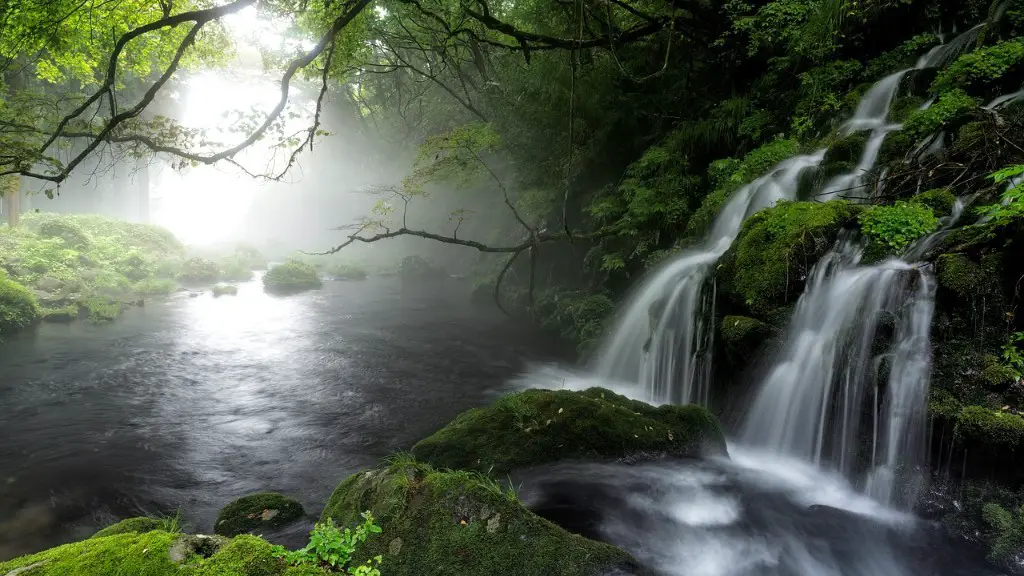Source of Wealth and Life
The Nile River is undoubtedly one of the most significant rivers in the world. It is the longest river on the planet, winding its way 4,258 miles (6,853 kilometers) through 11 countries in Africa, including Egypt, Sudan, South Sudan, and Uganda. The river has a rich and varied history, as well as an incredible importance to the people and wildlife that depend on it.
The ancient Egyptians considered the Nile to be a source of life, unifying the many different areas of Egypt. The river was the source of freshwater, fertile soil, and the transportation network that linked the different parts of the country. It was venerated as the ultimate source of Egypt’s riches and power, and composed of a number of Nile gods and goddesses, such as Isis and Osiris.
The unique deposits of soil and rock from the Blue and White Niles have formed an alluvial floodplain—a broad flat valley containing very fertile soil. This soil is unlike any other in Africa, and was an important factor in the ancient Egyptians’ ability to develop and maintain an advanced civilization.
The Nile was also home to a wide range of wildlife, including the hippopotamus, crocodiles, and many species of fish, birds, and reptiles. The river is not only the source of sustenance and life, but is also believed to be the source of spiritual and magical powers.
The Nile provided the ancient Egyptians with the lifeblood they needed to prosper and exist as a people. The mighty river was also home to a number of religions and rituals, but it was most associated with fertility and the growth of crops, including wheat and barley.
The Nile provided more than sustenance for the ancient Egyptians—it was their source of wealth. The Nile was the source of an abundance of trade goods and goods from foreign lands, including gold, ivory, and spices. It also provided access to the Red Sea and the Mediterranean, allowing for goods to be transported to distant lands.
The modern-day importance of the Nile can be seen in its vital role in the development of the region’s economy. It still provides sustenance and water to the countries that surround it, and supports the fishing and agricultural industries. In recent years, countries such as Egypt, Sudan, and Ethiopia have become increasingly interested in developing the region, with plans to build dams, irrigation systems, and hydroelectric power plants.
Dyne of the Pharaohs
The Ancient Egyptians often referred to the Nile as “the way of the Pharaohs,” due to its importance to their dynasty and its worship. Pharaohs connected themselves to the river, with many making pilgrimages to the source of the Nile and having elaborate ceremonies performed at the delta.
The River Nile has been a symbol of stability and strength for centuries, contending with its violent inundations and treacherous waters. The Nile has adapted with Egypt’s changing government, demonstrating remarkable resilience and strength.
The legacy of the Nile is so enduring that it has been admired by many cultures throughout history, including those of Ancient Rome and Greece. The idea of a river as a source of life has been transferred to other religions and mythologies, making the river even more significant.
The ancient Egyptians believed that the rains that filled the rivers and swamps were initiated by their own gods. To them, the Nile was the symbol of fertility and regeneration and the river was worshipped as part of their religion. They used it as a source for their wealth and well-being, with its waters impacting their beliefs, language and way of life.
The ancient Egyptians also believed that the Nile was the source of all existence. The annual flooding of the Nile made it the source of fertility and abundance, guaranteeing the best harvest possible. The early Egyptians developed their calendar based on the rising and flooding waters of the river, relating their own solar calendar with the cycles of the Nile.
The Nile has come to symbolize the human spirit, with its constantly changing yet consistent waters representing the ever changing yet essential aspects of our lives. The ancient Egyptians embraced the Nile as the source of all life, just as modern day Egyptians are still dependent on it.
Lifeblood of African Communities
The Nile River is one of the most essential resources within the African continent. It is the main source of water and sustenance for 11 African countries, at least 216 million people, and countless species of wildlife. It is the largest source of water for agriculture and the basis for many vibrant fishing communities.
The Nile is an essential part of the African economy, providing an abundance of fish, water, and transportation. The river also supports pastoralists, who depend on the river for their livestock, and provides energy from hydroelectric power stations.
The river is also an important source of spiritual connection and religious ritual for many African cultures, with certain parts of the river seen as sacred by those who live near it. In fact, the Nile has been linked to various religions, including Christianity, Islam, and traditional African beliefs.
Along with providing life, the Nile River is also a source of death. Over millions of years, the river has been a major source of flooding, such as the annual floods that occur in the Sudan. Countries that rely on the Nile, such as Egypt and Sudan, are particularly vulnerable to the river’s effects. In recent years, the use of dams, canals, and other forms of infrastructure have been used to tame the river and make it more predictable.
The Nile River is the lifeblood of African communities, sustaining the lives of millions of people who live within its reach. Its immense cultural and religious significance, as well as its economic and environmental importance, make it a unique and vital part of the African landscape.
Economic Impact
The economic impact of the Nile River is far-reaching and significant. The river and its tributaries have been a source of sustenance, transportation and commercial activity for thousands of years. Today, it is the lifeblood of the African economy.
The Nile is an important source of transportation and commercial activity, providing an abundance of water, fish, and other valuable resources. It is an essential link between the countries of the Nile River Basin and the Mediterranean, providing an essential trade route.
The Nile is also a vital source of energy. Over the past few decades, countries located along the river, such as Uganda and Ethiopia, have invested heavily in hydroelectric power plants along its waters. These power plants are both cost-effective and clean sources of energy that help meet the electricity needs of millions of people.
Finally, the Nile River is an important source of tourism, as well. From the ancient monuments and temples of Egypt to the lush green vegetation of the river’s banks, there are many sights to see. People from all over the world converge on the banks of the Nile for holidays and other important events, bringing an influx of tourism and economic activity to the region.
The Nile River is an essential economic force in Africa, providing the lifeblood of sustenance and livelihood to millions of people. Its unique geological and cultural significance make it one of the most important and impressive rivers in the world.
Environmental Impact
The Nile River has been a source of life and sustenance for humans and wildlife for millennia. However, its vast impact on the environment is a growing concern. The river affects everything from wildlife habitats to air and soil quality.
The river has become increasingly polluted due to poor agricultural practices, industrial waste, and population growth. This has led to an increase in algal blooms and a decrease in the number of fish species, particularly in Egypt and Sudan. In addition, overfishing and the use of illegal fishing methods has led to a significant decline in fish abundance in the river.
The Nile is also threatened by climate change. Rising temperatures will lead to reduced rainfall, decreased water levels, and increased water evaporation. In addition, changes in precipitation patterns can result in erratic flooding, as well as drought-induced soil degradation.
Finally, the Nile is also threatened by damming and other infrastructure projects. The construction of dams, canals, and other water projects can disrupt water flow, leading to water loss and land degradation. These practices can also have an impact on local wildlife and ecosystems.
The Nile River is an integral part of the African landscape and its economic and environmental impact cannot be overstated. To ensure the river’s continued success, efforts must be made to reduce pollution, protect wildlife, and conserve its resources.
Conclusion
The Nile River is an iconic river, filled with history, culture and environmental significance. From its importance to the ancient Egyptians to its importance in the modern day African economy and ecology, the Nile is a source of life and livelihood for many.
The presence of dams, population growth, and climate change are threatening the river and its wildlife. It is up to us, as stewards of this precious resource, to strive to protect the river and ensure its future health.





